
The CMS experiment has just reported the observation of quantum entanglement between a top quark and a top antiquark, simultaneously produced at the LHC.
In quantum mechanics, a system is said to be entangled if its quantum state cannot be described as a simple superposition of the states of its constituents. If two particles are entangled, we cannot describe one of them independently of the other, even if the particles are separated by a very large distance. When we measure the quantum state of one of the two particles, we instantly know the state of the other. The information is not transmitted via any physical channel; it is encoded in the correlated two-particle system.
Quantum information is a field of physics that was born with the work of John Bell, a CERN physicist, in the mid 1960’s. Soon after, Aspect, Clouser, and other physicists did important pioneering experimental work to test “Bell’s theorem”, and in 2007 Zeilinger’s team convincingly demonstrated the existence of entanglement between two photons, too far away from each other for the information to travel between them at the speed of light. This breakthrough brought Aspect, Clauser, and Zeilinger the 2022 Nobel Prize in Physics, “for experiments with entangled photons, establishing the violation of Bell inequalities and pioneering quantum information science”. Quantum entanglement was mostly examined for states of photons and electrons until 2023, when ATLAS reported the observation of entanglement in the top quark-antiquark system.
The CMS analysis was performed on the well-understood data sample collected in 2016 and focuses on top quark-antiquark pairs that are produced almost at rest. In these conditions, and among ordinary top quark pairs, the measurement could be affected by the presence of a hypothetical bound state that could be formed by the quark-antiquark top pair (“toponium” state). As shown in Fig. 1, the measured values of the entanglement variable D, basically the fraction of events with both top quarks having spins in the same direction versus the fraction with opposite spins, are much smaller than the limit above which the two particles can be considered “separable”. This is true irrespective of whether we consider or not the presence of the toponium state. “I am excited to be involved in an analysis that, for the first time, accounts for the potential effect of toponium in assessing the entanglement between the top quark and its antiparticle”, said Andrew Wildridge, a PhD student at Purdue University who participated in the analysis work.

Figure 1: Measured entanglement variable D (black circles), compared with three calculations, including (filled) or not (open) contributions from the toponium state, and with the limit above which the two particles can be considered “separable”.
Even if the toponium bound-state exists, the new CMS result confirms the existence of entanglement between the top quark and its antiparticle beyond reasonable doubt. The two states are found entangled with a significance exceeding the famous five standard deviations discovery threshold and in agreement with the Standard Model prediction. As Giulia Negro, a postdoctoral researcher at Purdue University, has said, "It's fascinating to see how the largest accelerator on Earth can also provide tools to explore fundamental quantum mechanics effects”. The observation of entanglement in top quark events provides a new quantum probe to the inner workings of the Standard Model.
Read more about these results:
-
CMS Physics Analysis Summary (TOP-23-001): "Probing entanglement in top quark production with the CMS detector "
-
Display of collision events: CERN CDS
-
@CMSExperiment on social media: LinkedIn - facebook - twitter - instagram
- Do you like these briefings and want to get an email notification when there is a new one? Subscribe here

